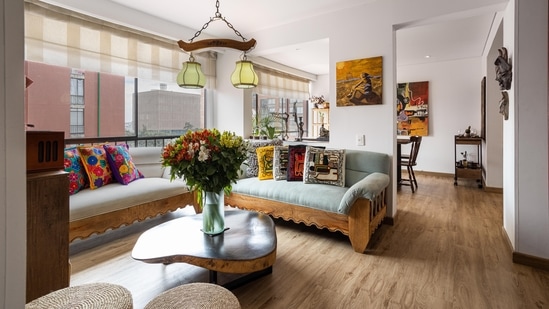Sustainable interior design offers a way to live well, with intention and care for both the people and the environment around them. It is about creating a home that nurtures health, comforts the senses and minimises its impact on the planet.
Simple interior upgrades for an energy-efficient home
Bringing her expertise to the same, Nishtha Dewan, Associate Director – Interiors at Morphogenesis, shared in an interview with HT Lifestyle, “By choosing non-toxic materials, energy-efficient solutions and natural elements, one can create an environment that feels good to live in while minimising their environmental footprint.”
She explained, “A key benefit of sustainable design is its positive impact on indoor air quality (IAQ). Many conventional materials release harmful chemicals, such as formaldehyde and benzene, into the air, which can negatively affect health. Sustainable alternatives, like bamboo, cork, reclaimed wood, and natural stone, are free from these toxins and help create cleaner, healthier spaces. Bamboo, a fast-growing renewable resource, works well for flooring, furniture and wall panels, offering both durability and a natural aesthetic.”

Materials like lime plaster or clay-based paints are also great choices for walls and ceilings. Nishtha Dewan elaborated, “These breathable materials prevent moisture buildup, reducing the risk of mold and mildew and improving IAQ. Natural insulation materials such as cotton, hemp and wool regulate temperature and humidity naturally, without releasing harmful chemicals, ensuring a comfortable indoor environment year-round.”
Eco-luxe living: The secret to a stylish, sustainable home
Indoor plants are a simple and effective way to boost IAQ while adding beauty to one’s home. Nishtha Dewan advised, “Plants like spider plants, peace lilies, and snake plants naturally filter out toxins, absorb carbon dioxide, and release oxygen. They’re especially beneficial in spaces with limited ventilation. Along with plants, natural fibre rugs made from wool, jute, or hemp, as well as non-toxic upholstery fabrics, help reduce exposure to harmful chemicals often found in synthetic materials.”
Energy efficiency is another cornerstone of sustainable interior design. Nishtha Dewan said, “LED track lighting, for example, provides targeted illumination with minimal energy use. Skylights and roof windows bring natural light into spaces like bathrooms or hallways, reducing the need for artificial lighting and improving air circulation, which also helps reduce reliance on air conditioning.”

She added, “Light wells and internal courtyards are other effective ways to bring daylight deep into the home, enhancing airflow and reducing electricity use. Landscaping in courtyards, with plants and seating areas, not only beautifies the space but also improves energy efficiency. External shading devices, like pergolas and trellises, control sunlight, allowing for diffused light while minimizing heat gain, especially on east- and west-facing windows. Architectural features like angled roofs, light shelves and sunshades help optimise natural light and maintain a consistent indoor temperature. These elements reduce the need for artificial lighting and cooling, making the home more energy-efficient.”
By integrating sustainable materials and strategies into one’s home design, a space becomes a reflection of both thoughtful design and environmental responsibility.




